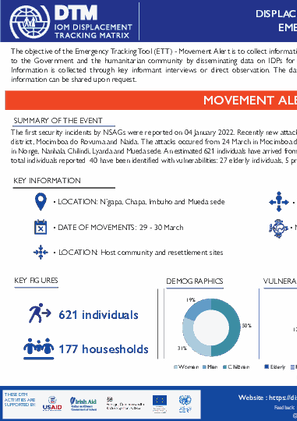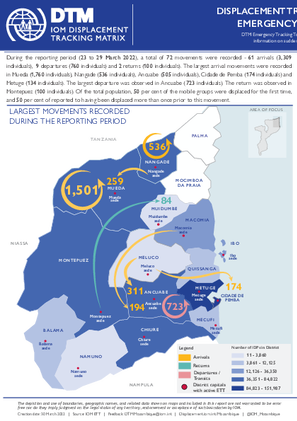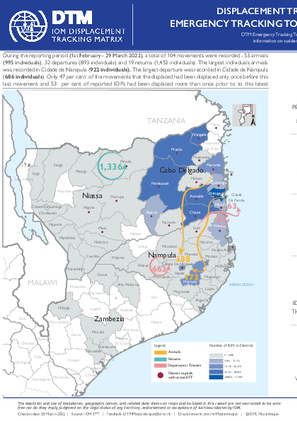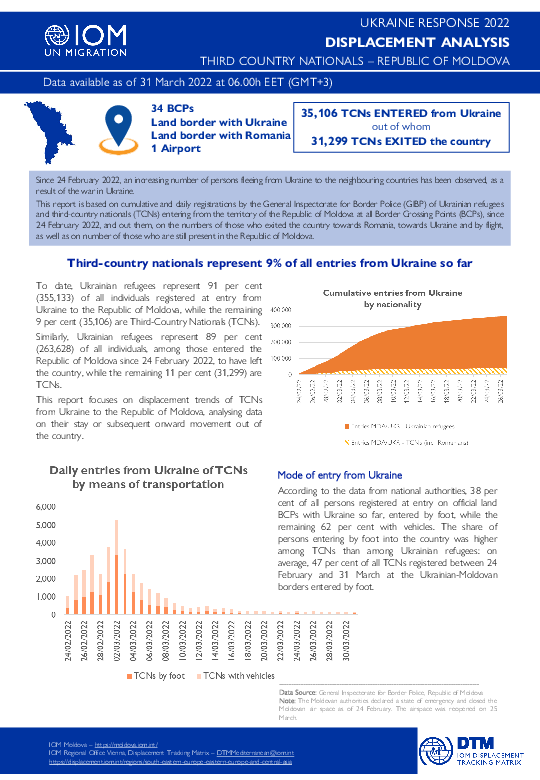-
Countries
-
Data and Analysis
-
Special Focus
-
Crisis Responses

Contact
DTM Mali, DTMMali@iom.int
Language
French
Location
Mali
Period Covered
Feb 01 2022
Feb 28 2022
Activity
- Flow Monitoring
Afin de mieux comprendre les mouvements et tendances migratoires, l’OIM, à travers la Matrice de suivi des déplacements (Displacement Tracking Matrix, DTM), met en œuvre l’activité de Suivi des flux de populations (Flow Monitoring, FM).
Le suivi des flux, qui est mis en œuvre en étroite collaboration avec les autorités et des partenaires nationaux et locaux, est composé de deux outils: l’enregistrement des flux (Flow Monitoring Registry, FMR), qui recueille des données clés sur l’ampleur, la provenance, la destination et les modalités des flux de mobilité, et les enquêtes individuelles (Flow Monitoring Survey, FMS), conduites auprès des voyageurs afin d’obtenir des informations sur les profils, parcours migratoires, et intentions des migrants. Le suivi des flux de populations récolte ainsi des données sur les flux et tendances migratoires, les profils des voyageurs et les parcours et intentions des migrants, afin de fournir une meilleure compréhension des mobilités.
Au Mali, la DTM recueille des données au niveau de 7 Points de suivi des flux (Flow Monitoring Points, FMP), répartis dans 6 régions afin d’obtenir une meilleure compréhension de l’ampleur, des tendances, des caractéristiques socio-démographiques et des parcours des flux de voyageurs traversant ces différents points.
Ce rapport présente les données recueillies dans le cadre des activités d’enregistrement des flux durant le mois de février 2022.

Contact
DTMMozambique@iom.int
Language
English
Location
Mozambique
Period Covered
Mar 23 2022
Mar 30 2022
Activity
- Event Tracking
- Mobility Tracking
The first security incidents by NSAGs were reported on 04 January 2022. Recently new attacks by the NSAGs have been reported in the following localities in Mueda district, Mocimboa do Rovuma and Naida. The attacks occured from 24 March in Mocimboa do rovuma and Naida. Five large IDP arrival movements have been recorded in Nonge, Nanhala, Chilindi, Lyanda and Mueda sede. An estimated 621 individuals have arrived from the 29 to 30 March 2022 from Mocimboa do rovuma and Naida. From the total individuals reported 40 have been identified with vulnerabilities: 27 elderly individuals, 5 pregnant women, 5 people with disabilities and 3 unaccompained children.

Contact
DTMMozambique@iom.int
Language
English
Location
Mozambique
Period Covered
Mar 23 2022
Mar 29 2022
Activity
- Event Tracking
- Mobility Tracking
During the reporting period (23 to 29 March 2022), a total of 72 movements were recorded - 61 arrivals (3,309 individuals), 9 departures (760 individuals) and 2 returns (100 individuals). The largest arrival movements were recorded in Mueda (1,760 individuals), Nangade (536 individuals), Ancuabe (505 individuals), Cidade de Pemba (174 individuals) and Metuge (134 individuals). The largest departure was observed in Ancuabe (723 individuals). The return was observed in Montepuez (100 individuals). Of the total population, 50 per cent of the mobile groups were displaced for the first time, and 50 per cent of reported to having been displaced more than once prior to this movement.

Contact
DTMMozambique@iom.int
Language
English
Location
Mozambique
Period Covered
Feb 01 2022
Mar 29 2022
Activity
- Event Tracking
- Mobility Tracking
During the reporting period (1st February - 29 March 2022), a total of 104 movements were recorded - 53 arrivals (995 individuals). 32 departures (893 individuals) and 19 returns (1,453 individuals). The largest individuals arrival was recorded in Cidade de Nampula (922 individuals). The largest departure was recorded in Cidade de Nampula (686 individuals). Only 47 per cent of the movements that the displaced had been displaced only once before this last movement and 53 per cent of reported IDPs had been displaced more than once prior to to this latest movement.

Contact
DTM Europe, DTMMediterranean@iom.int
Language
English
Location
Republic of Moldova
Period Covered
Mar 09 2022
Mar 27 2022
Activity
- Survey
- Flow Monitoring
Since 24 February 2022, increasing numbers of refugees and third-country nationals entering the Republic of Moldova have been registered amid the war in Ukraine. As of 27 March, Moldovan authorities have reported 381,448 arrivals from Ukraine, of whom 346,735 are Ukrainian refugees and 34,713 third-country nationals.
This report is based on a survey of displacement patterns, needs and intentions commissioned by the International Organization for Migration (IOM) in partnership with UN Women. Face-to-face surveys were conducted by trained enumerators from CBS-AXA Research at entry, exit, transit points and accommodation centres with Ukrainian refugees and third-country nationals. Data were collected and stored through a mobile application.
This report presents a short analysis based on the 4,384 interviews conducted between 9 and 27 March 2022, out of which 3,822 were interviewed at four Moldovan border crossing points – Otaci and Palanca (at entry), and Leuseni and Giurgiulesti (at exit) – as well as in three transit locations – MoldExpo, the Ukrainian Consulate, and a bus station in Chisinau, the capital city. Additionally, 562 interviews were conducted in temporary placement centres and private accommodations, using an extended questionnaire based on the Displacement Tracking Matrix tool.

Contact
DTM Europe, DTMMediterranean@iom.int
Language
English
Location
Republic of Moldova
Period Covered
Feb 24 2022
Mar 31 2022
Activity
- Flow Monitoring
- Migrants presence
To date, Ukrainian refugees represent 91 per cent (355,133) of all individuals registered at entry from Ukraine to the Republic of Moldova, while the remaining 9 per cent (35,106) are Third-Country Nationals (TCNs).
Similarly, Ukrainian refugees represent 89 per cent (263,628) of all individuals, among those entered the Republic of Moldova since 24 February 2022, to have left the country, while the remaining 11 per cent (31,299) are TCNs.
This report focuses on displacement trends of TCNs from Ukraine to the Republic of Moldova, analyzing data on their stay or subsequent onward movement out of the country.

Contact
DTMcovid19@iom.int
Language
English
Location
Global
Snapshot Date
Mar 28 2022
Activity
- Other
The current outbreak of COVID-19 has affected global mobility in the form of various travel disruptions and restrictions. To better understand how COVID-19 affects global mobility, DTM has developed a COVID-19 database mapping the different restrictions to provide a global overview. For this, DTM uses the IATA site as the primary source of restrictions with the information reported per country and territory, and to the country of application.
Data collected includes:
- Date of restriction
- Country, territory or area of restriction
- Countries, territories or areas on which restrictions were imposed
- Type of restriction- total restriction, or conditional restriction – such as medical/ and or visa restriction
This DTM COVID-19 Travel Restrictions Output presents an analysis based on country imposing, the country being imposed upon, and the aggregation of the restriction type. The aim of the data analysis is to provide an overview of the COVID-19 outbreak on global mobility and to help identify and develop responses.

Contact
DTM Nigeria, AllUsersInDTMNigeria@iom.int
Language
English
Location
Nigeria
Period Covered
Mar 27 2022
Mar 27 2022
Activity
- Event Tracking
- Mobility Tracking
On 27 March 2022, a fire outbreak was reported at Sulumri Bakin Kwalta Camp in Maiduguri M.C. LGA of Borno State. The fire damaged and destroyed shelters and belongings of numerous IDP households.
The fire incident fully destroyed 69 emergency shelter, 14 temporary shelters, affecting a total of 482 individuals in 91 households. The affected individuals included 276 children, 115 women and 91 men.
Additionally, four goats died in the fire outbreak and other properties were destroyed. A block of shower and toilets were partially damaged by the fire.

Contact
DTM Nigeria, AllUsersInDTMNigeria@iom.int
Language
English
Location
Nigeria
Period Covered
Mar 28 2022
Mar 28 2022
Activity
- Event Tracking
- Mobility Tracking
On 28 March 2022, a fire outbreak was reported at Muna El Badawy Camp in Jere LGA of Borno State. The fire damaged and destroyed shelters and belongings of numerous IDP households.
The fire incident fully destroyed 271 makeshift shelters and partially damaged 2 makeshift shelter, affecting a total of 1,106 individuals in 243 households. The affected individuals included 575 children, 310 women and 221 men.
NEEDS
The victims of the fire outbreak are currently residing with friends and relatives in the camp while they are attempting to rebuild their shelters. They are in desperate need of shelter assistance. Other needs include food and NFIs.
RESPONSE
At the time of writing, no assistance has been rendered to the affected population.

Contact
DTM Nigeria, AllUsersInDTMNigeria@iom.int
Language
English
Location
Nigeria
Period Covered
Mar 21 2022
Mar 27 2022
Activity
- Event Tracking
- Mobility Tracking
The DTM Emergency Tracking Tool (ETT) is deployed to track and to collect information on large and sudden population movements, provide frequent updates on the scale of displacement and quantify the affected population when needed. As a sub-component of the Mobility Tracking methodology in Nigeria. ETT utilises direct observation and a broad network of key informants to capture best estimates of the affected population per location, enabling targeted humanitarian response planning.
Between 21 and 27 March 2022, a total of 2,152 movements were recorded in Adamawa and Borno States. The recorded movements consisted of 1,632 arrivals and 520 departures. Arrivals were recorded at locations in Askira/Uba, Bama, Damboa, Gwoza, Kala/Balge, Monguno and Ngala Local Government Areas (LGAs) of the most conflict-affected state of Borno and in Fufore, Girei, Gombi, Hong, Lamurde, Maiha, Michika, Numan, Song and Yola North LGAs of Adamawa State.
Departures were recorded in Askira/Uba, Bama and Gwoza LGAs of Borno State and in Fufore, Gombi, Hong, Lamurde, Maiha, Mubi South, Numan, Song, Yola North and Yola South LGAs of Adamawa State. ETT assessments identified the following movement triggers: voluntary relocation (1,051 individuals or 49%), improved security (504 individuals or 23%), poor living conditions (371 individuals or 17%), military operations (135 individuals or 6%), seasonal farming (58 individuals or 3%) and conflicts/attacks (33 individuals or 2%).